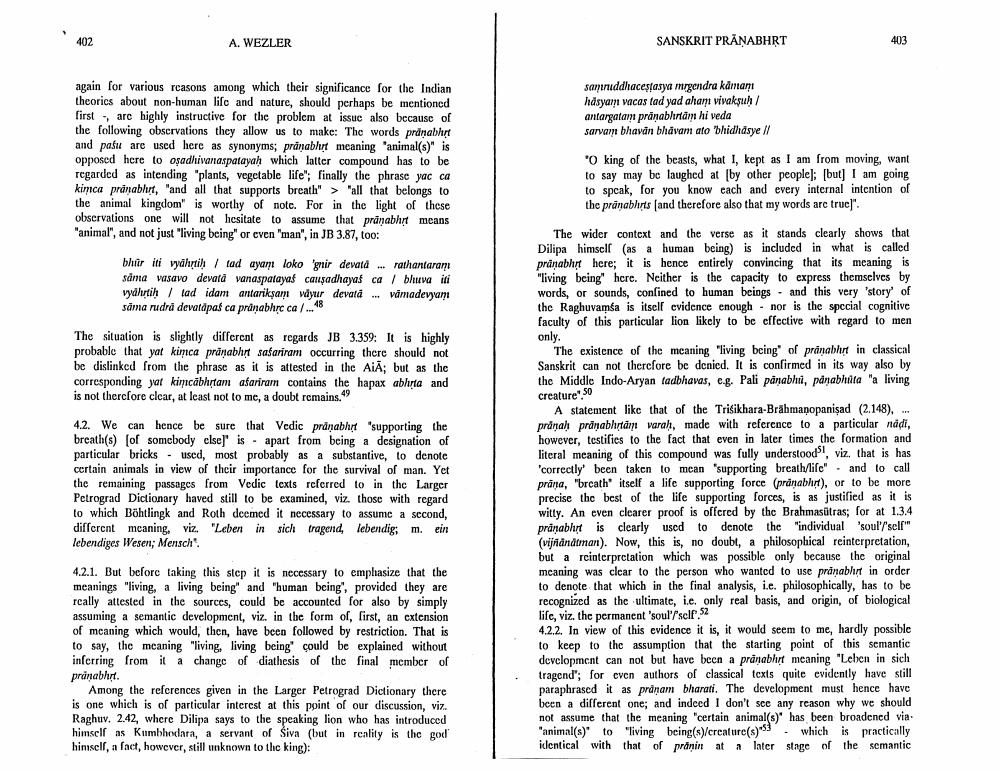Book Title: Sanskrit Pranabhrt Or What Supports what Author(s): A Wezler Publisher: A Wezler View full book textPage 6
________________ 402 A. WEZLER SANSKRIT PRĀNABHRT samruddhaceştasya mrgendra kamam häsyarı vacas tad yad ahan vivaksuh/ antargatam prānabhrtam hi veda sarvam bhavān bhávam ato bhidhāsye // again for various reasons among which their significance for the Indian theories about non-human life and nature, should perhaps be mentioned first are highly instructive for the problem at issue also because of the following observations they allow us to make: The words pranabhrt and pašu are used here as synonyms; pranabhurt meaning "animal(s)" is opposed here to osadhivanaspatayah which latter compound has to be regarded as intending "plants, vegetable life"; finally the phrase yac ca kimca pränabhrt, "and all that supports breath" > "all that belongs to the animal kingdom" is worthy of note. For in the light of these observations one will not hesitate to assume that prāṇabhịt means "animal", and not just "living being" or even "man", in JB 3.87, too: "O king of the beasts, what I, kept as I am from moving, want to say may be laughed at [by other people]; [but] I am going to speak, for you know each and every internal intention of the pránabhurts and therefore also that my words are true)". bhir iti vyährtih / tad ayam loko gir devatd ... rathantaram sama vasavo devata vanaspatayaf causadhayas ca / bhuva iti vydlrtih / tad idam antariksam wäyur devatá ...vdmadeyanı sāma rudrā devatapaś ca pränabhrc ca/ ... 8 The wider context and the verse as it stands clearly shows that Dilipa himself as a human being) is included in what is called präņabhịt here; it is hence entirely convincing that its meaning is "living being" here. Neither is the capacity to express themselves by words, or sounds, confined to human beings - and this very 'story of the Raghuvamsa is itself evidence enough. nor is the special cognitive faculty of this particular lion likely to be effective with regard to men only. The existence of the meaning "living being of pränabhrt in classical Sanskrit can not therefore be denied. It is confirmed in its way also by the Middle Indo-Aryan tadbhavas, e.g. Pali panabhii, panabhita "a living The situation is slightly different as regards JB 3.359: It is highly probable that yat kimca prānabhrt safariram occurring there should not be dislinked from the phrase as it is attested in the AiA; but as the corresponding ya kimcābh tam afariram contains the hapax abhira and is not therefore clear, at least not to me, a doubt remains. creature':50 4.2. We can hence be sure that Vedic prāṇabhyt "supporting the breath(s) (of somebody else)' is - apart from being a designation of particular bricks - used, most probably as a substantive, to denote certain animals in view of their importance for the survival of man. Yet the remaining passages from Vedic texts referred to in the Larger Petrograd Dictionary haved still to be examined, viz. those with regard to which Böhtlingk and Roth deemed it necessary to assume a second, different mcaning, viz. "Leben in sich tragend, lebendig; m. ein lebendiges Wesen; Mensch 4.2.1. But before taking this step it is necessary to emphasize that the meanings "living, a living being" and "human being provided they are really attested in the sources, could be accounted for also by simply assuming a semantic development, viz. in the form of first, an extension of meaning which would, then, have been followed by restriction. That is to say, the meaning "living, living being could be explained without inferring from it a change of diathesis of the final member of pranabhrt. Among the references given in the Larger Petrograd Dictionary there is one which is of particular interest at this point of our discussion, viz. Raghuv. 2.42, where Dilipa says to the speaking lion who has introduced himself as Kumbhodara, a servant of Siva (but in reality is the god' hinsell, a fact, however, still unknown to the king): A statement like that of the Tribikhara-Brahmanopanişad (2.148).... pranah prdnabhta varah, made with reference to a particular nådi, however, testifies to the fact that even in later times the formation and literal meaning of this compound was fully understood viz. that is has 'correctly been taken to mean "supporting breath/life" . and to call prāna, "brcath" itself a life supporting force (pranabh), or to be more precise the best of the life supporting forces, is as justified as it is witly. An even clearer proof is offered by the Brahmastras, for at 1.3.4 prānabhrt is clearly used to denote the "individual 'soul''self" (vijnandtman). Now, this is, no doubt, a philosophical reinterpretation, but a reinterprctation which was possible only because the original meaning was clear to the person who wanted to use pränabhrt in order to denote that which in the final analysis, i.e. philosophically, has to be recognized as the ultimate, i.e. only real basis, and origin, of biological life, viz. the permanent 'soul/self. 4.2.2. In view of this evidence it is, it would seem to me, hardly possible to keep to the assumption that the starting point of this semantic development can not but have been a pränabhrt meaning "Lehen in sich tragend"; for even authors of classical texts quite evidently have still paraphrased it as prdņam bharati. The development must hence have been a different one; and indeed I don't see any reason why we should not assume that the meaning "certain animal(s)' has been broadened via: "animal(s)" to "living being(s)/creature(s)* . which is practically identical with that of pränin at a later stage of the semanticPage Navigation
1 ... 4 5 6 7 8 9 10 11
